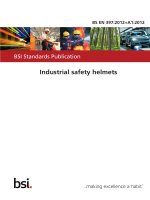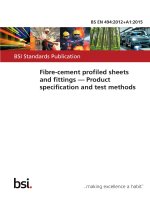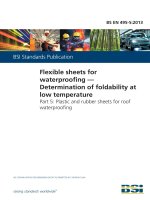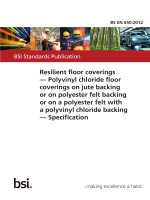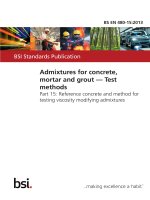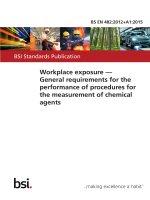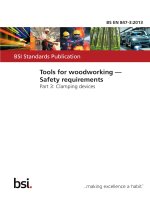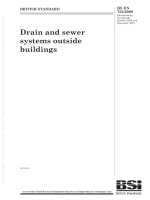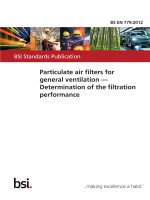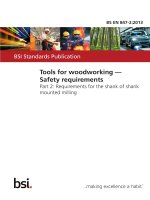Bsi bs en 62075 2012 (2013)
Bạn đang xem bản rút gọn của tài liệu. Xem và tải ngay bản đầy đủ của tài liệu tại đây (1.44 MB, 40 trang )
BS EN 62075:2012
Incorporating corrigendum March 2013
BSI Standards Publication
Audio/video, information
and communication
technology equipment —
Environmentally conscious
design
BRITISH STANDARD
BS EN 62075:2012
National foreword
This British Standard is the UK implementation of EN 62075:2012,
incorporating corrigendum March 2013. It is identical to IEC 62075:2012.
It supersedes BS EN 62075:2008 which is withdrawn.
The UK participation in its preparation was entrusted to Technical
Committee EPL/100, Audio, video and multimedia systems and
equipment.
A list of organizations represented on this committee can be obtained
on request to its secretary.
This publication does not purport to include all the necessary provisions
of a contract. Users are responsible for its correct application.
© The British Standards Institution 2013.
Published by BSI Standards Limited 2013
ISBN 978 0 580 82644 3
ICS 13.020.99; 33.160
Compliance with a British Standard cannot confer immunity from
legal obligations.
This British Standard was published under the authority of the
Standards Policy and Strategy Committee on 31 January 2013.
Amendments/corrigenda issued since publication
Date
Text affected
30 June 2013
Implementation of CENELEC corrigendum
March 2013: modification to EN Endorsement
notice
BS EN 62075:2012
EN 62075
EUROPEAN STANDARD
NORME EUROPÉENNE
EUROPÄISCHE NORM
December 2012
ICS 33.160
Incorporating corrigendum March 2013
English version
Audio/video, information and communication technology equipment Environmentally conscious design
(IEC 62075:2012)
Equipements relatifs aux technologies de
l'audio/vidéo, de l'information et de la
communication Conception éco-environnementale
(CEI 62075:2012)
Audio/Video-, Informations- und
Kommunikationstechnikgeräte –
Umweltbewusstes Design
(IEC 62075:2012)
This European Standard was approved by CENELEC on 2012-10-24. CENELEC members are bound to comply
with the CEN/CENELEC Internal Regulations which stipulate the conditions for giving this European Standard
the status of a national standard without any alteration.
Up-to-date lists and bibliographical references concerning such national standards may be obtained on
application to the CEN-CENELEC Management Centre or to any CENELEC member.
This European Standard exists in three official versions (English, French, German). A version in any other
language made by translation under the responsibility of a CENELEC member into its own language and notified
to the CEN-CENELEC Management Centre has the same status as the official versions.
CENELEC members are the national electrotechnical committees of Austria, Belgium, Bulgaria, Croatia, Cyprus,
the Czech Republic, Denmark, Estonia, Finland, Former Yugoslav Republic of Macedonia, France, Germany,
Greece, Hungary, Iceland, Ireland, Italy, Latvia, Lithuania, Luxembourg, Malta, the Netherlands, Norway, Poland,
Portugal, Romania, Slovakia, Slovenia, Spain, Sweden, Switzerland, Turkey and the United Kingdom.
CENELEC
European Committee for Electrotechnical Standardization
Comité Européen de Normalisation Electrotechnique
Europäisches Komitee für Elektrotechnische Normung
Management Centre: Avenue Marnix 17, B - 1000 Brussels
© 2012 CENELEC -
All rights of exploitation in any form and by any means reserved worldwide for CENELEC members.
Ref. No. EN 62075:2012 E
BS EN 62075:2012
EN 62075:2012
-2-
Foreword
The text of document 108/448/CDV, future edition 2 of IEC 62075, prepared by IEC/TC 100, "Audio, video
and multimedia systems and equipment" was submitted to the IEC-CENELEC parallel vote and approved
by CENELEC as EN 62075:2012.
The following dates are fixed:
•
•
latest date by which the document has
to be implemented at national level by
publication of an identical national
standard or by endorsement
latest date by which the national
standards conflicting with the
document have to be withdrawn
(dop)
2013-07-24
(dow)
2015-10-24
This document supersedes EN 62075:2008.
EN 62075:2012 includes the following significant technical changes with respect to EN 62075:2008:
EN 62075:2012 is primarily an editorial revision that adds information related to the modifications noted in
certain definitions and updating of regulation references.
NOTE
The following print types are used:
– requirements: in roman type;
– test specifications: in italic type;
– notes: in small roman type.
Words in bold in the text are defined in Clause 3. When a definition concerns an adjective, the adjective and the associated noun
are also in bold.
Attention is drawn to the possibility that some of the elements of this document may be the subject of
patent rights. CENELEC [and/or CEN] shall not be held responsible for identifying any or all such patent
rights.
Endorsement notice
The text of the International Standard IEC 62075:2012 was approved by CENELEC as a European
Standard without any modification.
In the official version, for Bibliography, the following notes have to be added for the standards indicated:
IEC 60065
NOTE Harmonized as EN 60065.
IEC 60950-1
NOTE Harmonized as EN 60950-1.
IEC 62018
NOTE Harmonized as EN 62018.
IEC 62430
NOTE Harmonized as EN 62430.
ISO 14001:2004
NOTE Harmonized as EN ISO 14001:2004 (not modified).
ISO 14050
NOTE Harmonized as EN ISO 14050.
ISO 14040:2006
NOTE Harmonized as EN ISO 14040:2006 (not modified).
BS EN 62075:2012
-3-
EN 62075:2012
Annex ZA
(normative)
Normative references to international publications
with their corresponding European publications
The following documents, in whole or in part, are normatively referenced in this document and are
indispensable for its application. For dated references, only the edition cited applies. For undated
references, the latest edition of the referenced document (including any amendments) applies.
NOTE When an international publication has been modified by common modifications, indicated by (mod), the relevant EN/HD
applies.
Publication
Year
Title
EN/HD
ISO 3741
-
Acoustics - Determination of sound power
EN ISO 3741
levels of noise sources using sound pressure Precision methods for reverberation rooms
-
ISO 3744
-
Acoustics - Determination of sound power
EN ISO 3744
levels of noise sources using sound pressure Engineering method in an essentially free field
over a reflecting plane
-
ISO 3745
-
Acoustics - Determination of sound power
EN ISO 3745
levels of noise sources using sound pressure Precision methods for anechoic and hemianechoic rooms
-
ISO 7779
-
Acoustics - Measurement of airborne noise
emitted by information technology and
telecommunications equipment
-
ISO 9296
-
Acoustics - Declared noise emission values of computer and business equipment
-
ISO 11201
-
Acoustics - Noise emitted by machinery and EN ISO 11201
equipment - Measurement of emission sound
pressure levels at a work station and at other
specified positions - Engineering method in an
essentially free field over a reflecting plane
-
ISO 11469
-
Plastics - Generic identification and marking
of plastic products
-
EN ISO 7779
EN ISO 11469
Year
BS EN 62075:2012
–2–
62075 © IEC:2012
CONTENTS
INTRODUCTION ..................................................................................................................... 5
1
Scope ............................................................................................................................... 6
2
Normative references ....................................................................................................... 6
3
Terms and definitions ....................................................................................................... 7
4
Life cycle thinking (LCT) aspects ...................................................................................... 9
5
Design requirements and recommendations ................................................................... 10
5.1
5.2
5.3
5.4
5.5
5.6
5.7
5.8
5.9
Annex A
General considerations .......................................................................................... 10
Material efficiency ................................................................................................. 10
Energy efficiency ................................................................................................... 11
5.3.1 General ..................................................................................................... 11
5.3.2 Energy modes and related energy efficiency measures............................... 11
5.3.3 Operational modes .................................................................................... 12
5.3.4 Energy saving modes ................................................................................ 13
5.3.5 Off modes .................................................................................................. 13
5.3.6 No load mode ............................................................................................ 14
5.3.7 General energy efficiency measures .......................................................... 14
Consumables and batteries ................................................................................... 15
5.4.1 Consumables............................................................................................. 15
5.4.2 Batteries .................................................................................................... 15
Emissions .............................................................................................................. 15
5.5.1 Chemical emissions ................................................................................... 15
5.5.2 Noise emissions ........................................................................................ 15
Product lifetime ..................................................................................................... 16
End of life .............................................................................................................. 16
Hazardous substances and preparations ............................................................... 17
Product packaging ................................................................................................. 18
(informative) Design guidance and design for environment checklist ...................... 19
Annex B (informative) Polymers compatibility guide ............................................................. 32
Annex C (informative) Examples of regulations .................................................................... 34
Bibliography .......................................................................................................................... 36
Figure 1 – Energy mode classification ................................................................................... 12
Table B.1 – Example of compatibility of various thermoplastics ............................................ 33
Table C.1 – Government environmental agency URLs .......................................................... 34
BS EN 62075:2012
62075 © IEC:2012
–5–
INTRODUCTION
Every product has an effect on the environment, which may occur at any or all stages of its
life cycle – raw-material acquisition, manufacture, distribution, use, and disposal. These
effects may range from low to significant; they may be short-term or long-term; and they may
occur at the local, regional or global level (or a combination thereof).
The interest of customers, users, developers and other stakeholders in environmental
aspects and effects of products is increasing.
Anticipating or identifying the environmental aspects of a product throughout its life cycle
may be complex. The environmental aspects of a product have to be balanced against
other factors, such as its intended use, performance, safety and health, cost, marketability,
quality and regulatory requirements. It is important to consider the product functionality within
the context of the system where it will be used.
The process of integrating environmental aspects into product design and development has
to be continuous and flexible, promoting creativity and maximizing innovation and
opportunities for environmental improvement. Environmental issues should be addressed in
the policies and strategies of the organization involved.
Early identification and planning enable organizations to make effective decisions about
environmental aspects that they control. This provides a better understanding of how their
decisions will affect environmental aspects controlled by others, for example, at the rawmaterial and parts acquisition or end of life stages.
The purpose of this document is to help designers of products in the field of audio/video,
information technology and communication technology to appropriately manage related
environmental issues within the design process.
This sector specific document takes into account the publication of the second edition of
ECMA-341 (2004), recent engineering best practices as well as current market and regulatory
environmental product requirements.
BS EN 62075:2012
–6–
62075 © IEC:2012
AUDIO/VIDEO, INFORMATION AND COMMUNICATION TECHNOLOGY
EQUIPMENT – ENVIRONMENTALLY CONSCIOUS DESIGN
1
Scope
This International Standard applies to all audio/video, information and communication
technology equipment marketed as final products, hereafter referred to as products.
Although this standard does not explicitly apply to individual components and subassemblies
to be incorporated into final products, component manufacturers also should consider this
standard, to enable manufacturers using such components to meet the requirements herein.
Only the intended use of products as defined by the manufacturer is within the scope of this
standard.
This standard specifies requirements and recommendations for the design of environmentally
sound products regarding
•
life cycle thinking aspects,
•
material efficiency,
•
energy efficiency,
•
consumables and batteries,
•
chemical and noise emissions,
•
extension of product lifetime,
•
end of life,
•
hazardous substances/preparations, and
•
product packaging.
This standard covers only criteria directly related to the environmental performance of the
product. Criteria such as safety, ergonomics and electromagnetic compatibility (EMC) are
outside the scope of this standard and covered by other standards.
2
Normative references
The following documents, in whole or in part, are normatively referenced in this document and
are indispensable for its application. For dated references, only the edition cited applies. For
undated references, the latest edition of the referenced document (including any
amendments) applies.
ISO 3741, Acoustics – Determination of sound power levels of noise sources using sound
pressure – Precision methods for reverberation rooms
ISO 3744, Acoustics – Determination of sound power levels and sound energy levels of noise
sources using sound pressure – Engineering methods for an essentially free field over a
reflecting plane
ISO 3745, Acoustics – Determination of sound power levels of noise sources using sound
pressure – Precision methods for anechoic and hemi-anechoic rooms
BS EN 62075:2012
62075 © IEC:2012
–7–
ISO 7779, Acoustics – Measurement of airborne noise emitted by information technology and
telecommunications equipment
ISO 9296, Acoustics – Declared noise emission values of computer and business equipment
ISO 11201, Acoustics – Noise emitted by machinery and equipment – Determination of
emission sound pressure levels at a work station and at other specified positions in an
essentially free field over a reflecting plane with negligible environmental corrections
ISO 11469, Plastics – Generic identification and marking of plastics products
3
Terms and definitions
For the purpose of this document the following terms and definitions apply.
3.1
chemical emissions
chemical substances and particulate matter emitted from a product into the air
3.2
consumable
user-replaceable part or piece of equipment that manufacturers place on the market for
direct sale for use in equipment
Note 1 to entry: Consumables include, for example, printer cartridges and photographic film, and not parts
required for repairs or product upgrades.
3.3
designer
person responsible for the design and development of a product under the supervision of the
manufacturer
Note 1 to entry:
See 3.12 for context with manufacturer.
3.4
end of life
life cycle stage of a product starting when it is removed from a use stage
3.5
energy efficiency
a comparative measure of energy required to achieve a particular performance
Note 1 to entry: A more precise definition is not applicable in this context as the output performance largely
depends on the specific device.
EXAMPLE
power.
For power supplies the energy efficiency is defined as the percentage of output power per input
3.6
environment
surroundings in which an organization operates, including air, water, land, natural resources,
flora, fauna, humans and their interrelation
[SOURCE: ISO 14001:2004, 3.5]
3.7
environmental aspect
element of an organization’s activities, products or services that can interact with the
environment
BS EN 62075:2012
–8–
62075 © IEC:2012
[SOURCE: ISO 14001: 2004, 3.6]
Note 1 to entry: A significant environmental aspect is one that has or can have a significant environmental
impact (ISO 14001:2004, 3.7).
3.8
environmental impact
any change to the environment, whether adverse or beneficial, wholly or partially resulting
from an organization’s environmental aspects
[SOURCE: ISO 14001:2004, 3.7]
3.9
environmental management system
part of the overall management system that includes organizational structure, planning
activities, responsibilities, practices, procedure, processes, and resources for developing,
implementing, achieving, reviewing and maintaining the environmental policy
[SOURCE: ISO 14001:2004, 3.8, modified to include notes as part of definition and eliminate
use of ISO 14001 defined terms]
3.10
hazardous substances and preparations
substance or preparation that can adversely impact the environment with immediate or
retarded effect
[SOURCE: IEC Guide 109:2003, 3.6, modified to include “preparations” in the definition and
eliminate the note]
3.11
life cycle
consecutive and interlinked stages of a product system, from raw material acquisition or
generation of natural resources to the final disposal
[SOURCE: ISO 14040:2006, 3.1]
3.12
manufacturer
organization responsible for the design, development and manufacture of a product in view
of its being placed on the market, regardless of whether these operations are carried out by
that organization itself or on its behalf
3.13
module
assembly of parts of a product with a function in itself (for example, a power supply)
including those separately put on the market as a product
3.14
organization
company, corporation, firm, enterprise, authority or institution, or part or combination thereof,
whether incorporated or not, public or private, that has its own functions and administration
[SOURCE: ISO 14001:2004, 3.16]
3.15
part
any piece or object of, or included with, a product
BS EN 62075:2012
62075 © IEC:2012
–9–
3.16
preparations
mixtures or solutions composed of two or more substances
EXAMPLE
Tin is a substance and solder is a preparation (an alloy) that may contain tin.
3.17
product
audio/video, information and communication technology equipment
3.18
recycling
reprocessing of products, modules or parts thereof for reuse or other purposes during their
end of life stage
3.19
renewable material
organic material not based upon fossil carbon sources
3.20
reuse
recycling of products, modules or parts by entering in a subsequent product use stage
3.21
skilled person
person with relevant education or experience to enable him or her to avoid dangers and to
reduce the likelihood of risks that may be created by the equipment
[SOURCE: IEC 60050-826:2004, 826-18-01, modified to eliminate electrical specificity]
3.22
substance
matter with an individual molecular identity
3.23
upgrading
process to enhance the functionality or capacity of a product
3.24
use stage
period of the product’s life from placing it into service until it enters its end of life stage
4
Life cycle thinking (LCT) aspects
Environmentally conscious design (ECD) according to IEC 62430 shall be based on the
concept of life cycle thinking (LCT), which requires consideration during the design and
development process of the significant environmental aspects of a product in all life cycle
stages.
Key elements of life cycle thinking are:
a) having an objective to minimize the overall adverse environmental impact of the product;
b) identifying, qualifying and where feasible, quantifying the significant environmental
aspects of the product;
c)
considering the trade-offs between environmental aspects and life cycle stages.
BS EN 62075:2012
– 10 –
62075 © IEC:2012
The above shall be initiated as early as possible in the design and development process,
when most opportunities exist to make changes and improvements to the product affecting its
overall environmental performance throughout its life cycle.
This LCT text has been intentionally copied for alignment reasons to use the same
understanding as in IEC 62430.
As a first step in LCT, the intended function of the product should be determined. In
subsequent design and development stages the influence of any applied business model
should be recognized.
NOTE 1 The life cycle stages of any product under control of the organization usually include the processing of
materials, manufacturing, distribution, use, maintenance, and end of life management (including reuse, recycling,
recovery and final disposal).
NOTE 2 When a product is part of a system, the environmental performance of one product during one or more
life cycle stages can be altered by other products in that system.
NOTE 3
5
5.1
ECD requires collaboration and contributions of all stakeholders along the supply chain.
Design requirements and recommendations
General considerations
The following requirements have been compiled for use when designing and developing
products as defined in the scope of this standard, as far as they can be practically influenced
by the designer.
The designer
–
shall identify the latest environmental related legal and market requirements (from
customers, government, environmental groups, industrial associations, etc.);
–
should do benchmarking addressing the comparison of energy efficiency, material
efficiency, and the use of hazardous substances and preparations;
–
should gather and evaluate experience from the subsequent manufacturing, sales,
product usage, maintenance and disposal stages;
to continually improve the process of environmentally conscious product design.
The entire environmental performance of the product should be evaluated, while the
considerations should give priority to those factors that can be substantially influenced
through product design and are identified as major environmental impacts (for example,
very often energy consumption). The evaluation should take into consideration the functions
and normal usage of the product as well as the technical and economical feasibility.
As a minimum, the designer shall document decisions by some means, such as by
maintaining a design checklist covering environmental aspects (an example for such a
checklist is provided in Annex A).
This standard requires certain product environmental characteristics to be made available in
a form the manufacturer deems appropriate.
Further applicable information may be made available in an environmental product
declaration (for example, ECMA-370).
5.2
Material efficiency
Material selection has an impact on the environment. When specifying materials, the
designer should consider design alternatives that:
BS EN 62075:2012
62075 © IEC:2012
– 11 –
–
reduce the variety of materials used;
–
reduce the amount of material used and consequently the weight of the product;
–
use materials that are considered to have lower adverse environmental impact;
–
seek to use materials that can be easily recycled.
Material-related end of life aspects are covered in 5.7. For replacing materials containing
hazardous substances and preparations, see 5.8.
5.3
5.3.1
Energy efficiency
General
To focus efforts on increasing energy efficiency, the designer shall be aware in which stage
of the product life cycle the product will consume the most energy.
The intended use patterns of the product, including where relevant its typical system
interactions, shall be considered. Where possible, the organization should strive for
improving the overall system performance in respect to energy efficiency.
Energy consumption information shall be made available (see 5.3.5 d) and 5.3.7).
5.3.2
Energy modes and related energy efficiency measures
Energy mode definitions and applied terms vary depending on the product group. Therefore,
rather than providing precise definitions of energy modes in this standard, modes are
described in generic terms as defined in 5.3.3 to 5.3.6 and illustrated in Figure 1. The intent is
to balance the technical complexity with the simplicity needed for ease of communication and
use.
NOTE Due to the high diversity of products covered by this standard, examples are intended to clarify the energy
modes and to guide the designer.
The designer shall identify specific energy modes that apply to the product under
development.
The designer shall consider energy efficiency measures for the identified energy modes
(described in more detail in 5.3.3 to 5.3.7).
Designers shall also identify where energy is consumed with the product and take steps to
reduce the overall energy consumption.
BS EN 62075:2012
– 12 –
62075 © IEC:2012
Energy
modes
Operational
modes
Energy saving
modes
Off
modes
On-maximum
Soft-off
On-normal
Hard-off
No load
mode
On-idle
IEC 1723/12
Figure 1 – Energy mode classification
5.3.3
Operational modes
Products perform their intended functions in the on-maximum, on-normal and on-idle
operational modes.
–
On-maximum: Operation with all options in use.
EXAMPLE 1 A television with maximum contrast, brightness and sound, or a personal computer with all slots and
bays populated and operating.
–
On-normal: Operation with default/standard configuration.
EXAMPLE 2
–
The factory setting of a computer display or a printer in active/run mode.
On-idle: Operation with minimum system load by user and ready to operate without delay.
EXAMPLE 3 A personal computer running with no user initiated task consuming significant computing resources,
or a printer in ready mode.
The designer shall consider:
–
using low power components and/or design options as well as efficient power supply
components to reduce the energy consumption in the on modes;
NOTE 1 The reason for the above is that less efficient designs result in higher heat dissipation in the system,
which leads to increased cooling requirements. By improving the energy efficiency of these designs in the
on-mode, it may become possible to apply passive cooling thereby avoiding the use of fans and the resulting
additional energy consumption.
NOTE 2
Energy efficiency improvements typically reduce costs and noise and improve serviceability.
BS EN 62075:2012
62075 © IEC:2012
–
– 13 –
identified modes (see 5.3.2) when specifying the power supply. The AC-DC conversion
efficiency should be high in the most used modes, for example, by applying voluntary
programs and agreements as described in 5.3.7;
EXAMPLE 4 For typical personal computers in office use, the on-idle mode might represent a substantial
percentage of the on-mode consumption and thus the conversion efficiency for this mode is necessarily high.
However, in many personal computers, the power supply loading is low in the on-idle mode, and hence often
the conversion efficiency is low.
NOTE 3 Another reason for a low loading and therefore reduced power supply efficiency is the inherent
extendibility of a system such as a personal computer. As such, the designer can decide to balance
extendibility vs. energy consumption.
–
the true specification needs for the product. For example, over-specifying the rating of the
power supply can lead to an energy inefficient design;
–
the effect of the operating environment specification provided to users and installers. For
example, over-specifying the maximum allowed ambient (room) operating temperature for
large telecom, server or storage units can lead to energy inefficiencies in the room cooling
systems.
5.3.4
Energy saving modes
Energy saving modes, often denoted as low power, sleep, deep sleep or stand-by, are states
in which the equipment is connected to an electrical supply and is ready to resume an
operational mode, within a user acceptable timeframe, through the use of remote control or
another signal. In complex systems, various energy save modes may be present.
EXAMPLE 1 Sleep [stand-by/suspend to RAM (random access memory) mode for computers], stand-by-active
high mode (set-top-box exchanging data with an external source but not providing picture or sound to the
television), stand-by-active low mode (DVD-recorder programmed for recording but not recording/providing picture
or sound to the television), stand-by-passive (television not providing picture or sound, but can be switched into
operational mode by the remote control).
The designer shall:
–
consider practical design options to automatically switch from on mode to energy save
modes. The energy save mode settings should be adjustable by the user and designed in
a way that it is likely to be adjusted if necessary to an alternative or custom setting, more
suitable to their typical use. Other innovative solutions shall be considered;
EXAMPLE 2 A computer monitor may activate sleep mode when the user is detected to have left the viewing area
or after a specified period of inactivity of manual input devices such as keyboard and mouse.
–
consider the effect of the time to resume on the user acceptance to use the energy save
modes;
EXAMPLE 3
The delay time for the first copy/print to start from energy save mode on a copier/printer.
–
consider design options to reduce the energy consumption in the energy save modes by
also applying similar methods as described in 5.3.3;
–
inform the user of the higher energy consumption if the energy save mode is disabled.
5.3.5
Off modes
While connected to an electrical supply, products consume the least power in the following
off modes:
–
Soft-off: The equipment is switched off by the device itself or initiated by the user via
remote control or command.
EXAMPLE 1
–
Printer in auto-off mode or computer after shutdown was completed.
Hard-off: The off-power state in which the device uses zero watt (minimum energy
consumption might occur due to line filters). The equipment is manually switched off with
the main power switch (see c) and d) below).
EXAMPLE 2 Monitors, televisions and laser printers switched off at the primary side of the power supply and thus
consuming no energy.
BS EN 62075:2012
– 14 –
62075 © IEC:2012
The designer shall
a) consider design options to automatically switch from energy save mode to an off mode
where practical,
b) consider design options to reduce the energy consumption in the soft off modes to lowest
values (minimum energy consumption might occur due to line filters),
c) consider a main power switch. If applicable, the main power switch should be placed on
the product such that the user can easily reach and use it,
d) prepare energy consumption data (energy level in watthours) for a state a user would
consider hard off but for which a power level of zero watt is not achievable and inform the
user through documentation or other means.
5.3.6
No load mode
No load mode is the mode in which external power supplies or chargers are connected to an
electrical supply, but are not connected to electrical or electronic equipment for which they
have been designed.
EXAMPLE
A mobile phone charger is plugged in, but the phone is not connected.
The designer shall consider design options that reduce energy consumption of no load mode
to the lowest value.
5.3.7
General energy efficiency measures
All available energy saving features shall be documented during the design process.
Information on the product’s energy consumption and, where applicable, its related energy
modes shall be made available to the user.
Designers shall consider the requirements of international programmes, applicable for the
product category, aimed to increase energy efficiency.
EXAMPLE 1 The Energy Star international programme has made a number of product specifications and
memoranda of understanding, available here: .
Designers should consider other agreements as applicable aimed to improve energy
efficiency.
The effects of the improved design decisions compared to previous similar designs should be
quantified and communicated to product marketing departments in order to enable them to
promote products with lower adverse total environmental impact through lower energy
consumption.
The designer should enable the most energy efficient on modes and transitions to energy
saving mode as the default modes with performance taken into consideration after transitions
to energy saving modes as the default mode. If this is not reasonably achievable, the user
shall be made aware of this and instructions on proper use of available energy saving controls
and/or settings shall be provided to users. Instructions may be included in product user
documentation in either printed or electronic form.
EXAMPLE 2 A user is made aware that enabling the wake-up on Local Area Network features prevents the
product from entering the soft-off energy saving mode.
If the product applies software and/or firmware, the designer shall be aware of the relevance
of those for the overall energy efficiency of a system. The designer should balance the
flexibility of software running on multipurpose devices and the energy efficiency of special
purpose hardware.
BS EN 62075:2012
62075 © IEC:2012
5.4
– 15 –
Consumables and batteries
5.4.1
Consumables
For consumables, designers shall also consider the guidance specified in 5.7.
Products should be designed such that the use of consumables can be optimized relative to
the functionality of the product. Designers should consider:
–
functions to reduce or save the use of consumables;
–
ease of replacement and maintenance of consumables.
The manufacturer shall provide users with information on the proper use of consumables
relative to the functionality of the product and, where appropriate, end of life management of
the consumables.
5.4.2
Batteries
Batteries shall comply with all applicable restrictions such as on hazardous substances and
preparations (see 5.8), design requirements on equipment containing batteries and, to the
extent possible, all international labelling requirements.
Batteries with reduced environmental impact shall be considered. When materials with
adverse environmental impact cannot be avoided (for example, mercury in button cells), the
material and its justification shall be documented during the design process.
Batteries shall be easily identifiable and removable, either by users or skilled persons,
except where the battery life span exceeds that of the product. In case the life span of the
battery exceeds that of a product, batteries shall be removable for end of life treatment.
Product documentation shall give advice for the safe removal of the battery by either users or
skilled persons. Information on batteries in the product shall be made available. This
information shall include details on the types of the batteries and their locations, as well as
proper procedures for safe removal and handling of the batteries, including information on
end of life management/proper battery disposal.
Designs that prolong the durability of batteries shall be considered.
5.5
5.5.1
Emissions
Chemical emissions
Products shall be designed such that chemical emissions with adverse environmental
impact during use are reduced wherever possible.
For products that use an electrostatic process, emission rates determined according to
ISO/IEC 28360 should be made available.
5.5.2
Noise emissions
The designer shall consider techniques to reduce noise emissions.
NOTE 1
Reduced noise emissions improve energy efficiency.
In particular, noise emissions shall be evaluated according to ISO 7779, for products covered
by ISO 7779 (or ECMA-74).
BS EN 62075:2012
– 16 –
62075 © IEC:2012
For products under the scope of this standard and not covered by a product specific
international standard noise test code, such as ISO 7779 (or ECMA-74), noise emissions do
not have to be evaluated.
If noise emissions are evaluated for products under the scope of this standard but not
covered by either ISO 7779/ECMA-74 or another product-specific international standard
noise test code, the basic sound power standards, ISO 3741, ISO 3744 or ISO 3745, and the
basic emission sound pressure standard, ISO 11201, shall be used. The test conditions used
should be recorded.
The resulting sound power levels and, where applicable, emitted sound pressure levels
(including emission sound pressure measurement distance if not covered by
ISO 7779/ECMA-74) shall be declared according to ISO 9296 (or ECMA-109) and should be
documented according to available eco-declaration standards (such as ECMA-370). The
levels shall be made available in the product information.
NOTE 2 The additional noise from cooling systems is a frequent issue for audio and video systems and
computers in home or silent office environments.
NOTE 3 The declared A-weighted sound power level L W Ad , according to ISO 9296, is a statistical maximum value
to account for product variation and lab-to-lab variations, and L W Ad is typically about 0,3 bels to 0,4 bels (3 dB to
4 dB) greater than the average A-weighted sound power level LW A , measured according to ISO 7779, ISO 3741,
ISO 3744 or ISO 3745. ISO 9296 (or ECMA-109) specifies how to determine and verify L W Ad .
5.6
Product lifetime
Where technically and economically feasible, products shall be designed to have a prolonged
useful life and be easy to upgrade and repair. However, designers shall consider the
balanced compromise of using up to date and efficient technology and prolonging the life of
inefficient products. Designers shall consider incorporating the following features:
–
use of common mechanical packages (such as covers and chassis) or common parts or
components that are used for multiple models in the product family or in multiple
generations of the same product, allowing for the reuse of common parts;
–
use of standardised parts that may be more easily replaced or repaired;
–
use of modules;
–
reuse of modules, parts and products, whenever applicable. Parts, which may be
targeted for reuse (for example, in maintenance and spare parts applications) should be
identified.
To encourage the optimisation of a product’s useful life, information on available options for
upgrading, expanding and repair of products shall be made available if appropriate.
NOTE 1 Specifics on design for upgradeability may need to be identified based on product categories, and/or
initial cost of a product. There are categories of products for which upgradeability features may not be applicable,
for example, single use cameras and pocket calculators.
NOTE 2
5.7
Some of the guidelines provided in 5.6 will aid serviceability.
End of life
Product design shall facilitate reuse, recycling and proper disposal at end of life.
The following design principles, where appropriate for the expected end of life processes,
shall be applied:
–
easy and safe separation of parts containing hazardous substances and preparations
shall be possible (see 5.8);
–
materials (including electronic modules) connected to case/housing parts or chassis
intended for different end of life treatment shall be easily separable;
BS EN 62075:2012
62075 © IEC:2012
– 17 –
–
disassembly down to the module level (for example, power supply, disk drive, circuit
board) shall be possible using commonly available tools and all such modules shall be
easily accessible;
–
mark type of polymer, copolymer, polymer blends or alloys of plastic parts, including
additives weighing 25 g or more and with a flat area of 200 mm 2 or more, in conformance
with ISO 11469.
NOTE 1
Safety and performance considerations may override some of the requirements mentioned above.
NOTE 2
There are categories of products for which dismantling may not be practical at end of life.
Considering the expected end of life processing, designers should:
–
limit the number of polymers used in the product. Combinations of non-compatible
materials which are not readily separated from each other shall be avoided, since this can
compromise effective recycling. The compatibility guideline in Annex B should be used in
selecting polymers when combinations of materials are intended to be used which could
not easily be separated from each other. Advice on whether particular combinations of
materials are readily compatible for the purposes of recycling can be obtained from
polymer suppliers, specialized plastics recyclers or manufacturers who compound
plastics;
–
use labels and other identification marks made from the same material as the body of the
products or a compatible material, where possible;
NOTE 3
There may be specific, for example, safety requirements for labels.
–
design for ease of disassembly;
–
avoid the use of:
–
•
non-recyclable composites;
•
coatings and surface finishes on plastic parts;
•
adhesive backed stickers or foams on plastic parts (if stickers are required, they
should be separable);
•
metal inserts in plastic parts (unless easily removable with common tools);
reduce the number and variety of:
•
welds and glued joints;
•
connections (for example, fasteners and screws);
•
steps necessary to remove targeted substances, preparations or parts in a treatment
process;
•
tools required for disassembly or extraction;
•
position changes that have to be made by the dismantler.
Designers shall be aware of product end of life regulations to ensure legal compliance for
products sold in targeted countries. Designers should prepare end of life treatment
information that includes:
–
identification of potentially valuable and/or re-usable parts;
–
identification of parts containing hazardous substances and preparations and the
location of such parts;
–
special handling and disposal precautions.
5.8
Hazardous substances and preparations
Reducing and/or eliminating hazardous substances and preparations shall be considered
as one of the priorities in the design of products. Designers shall be aware of (international,
regional and national) prohibitions on the use of hazardous substances and preparations to
ensure legal compliance for products sold in targeted countries. Consult Annex C for a list of
examples of such regulations.
BS EN 62075:2012
– 18 –
62075 © IEC:2012
Designers shall attempt to reduce the use of substances that require special handling or
disposal during the product recycling process.
Appropriate information on parts requiring special handling or disposal shall be made
available to product users and recyclers.
When hazardous substances and preparations other than those that are restricted cannot
be avoided, they shall be identified and an indication as to why they cannot be avoided shall
be recorded during the design process.
5.9
Product packaging
Packaging material selection and its design has an impact on the environment. When
specifying materials and designing packaging, the designer should consider design
alternatives that:
–
reduce the amount of material used and consequently the weight and size of the package;
–
use materials that are considered to have lower adverse environmental impact;
–
use recycled materials;
–
use renewable/recyclable (considering available recycling technologies) materials.
As a minimum requirement the designer shall ensure compliance to international, regional
and national regulations, concerning:
–
restrictions on hazardous substances and preparations;
–
recyclability, such as reuse or recycling;
–
appropriate marking (material content) of packaging materials.
BS EN 62075:2012
62075 © IEC:2012
– 19 –
Annex A
(informative)
Design guidance and design for environment checklist
A.1
General
The design checklist is intended solely for use of the designer. It is not intended to document
environmental features for end users or to be used by end users to compare products.
This annex provides guidance in the form of an example checklist that may be used to
evaluate and record the requirements and recommendations according to this standard during
the design and/or redesign process. This is a generic checklist and not every item on the
checklist is applicable to every product and/or product group.
It is recognised that there is a wide range of products covered under the scope of this
standard. For this reason it is not possible to provide a unique checklist for every type of
product or family (group) of products. Designers should generate a design checklist based
on the design requirements of this standard and through other reference material and
technical reports that will accurately reflect their specific product or family of products.
A.2
Life cycle thinking aspects
A.2.1
The organization has a management system such as an environmental
management system in place covering environmental product design aspects.
( ) ISO 14001 (
) Other, please list: .....................................................................................
( ) No
A.2.2
The designer has followed those policies/programs.
( ) Yes
( ) No
A.2.3
It has been checked that any emphasis on a single stage of the life cycle of a
product does not negatively alter the environmental impacts in other stages.
( ) Yes, describe briefly ..........................................................................................................
( ) No, please explain why:......................................................................................................
A.2.4
The designer has checked with the relevant departments within the
organization, which of the following aspects are considered in the
environmental policy or programs of the organization:
( ) Extraction/processing of raw materials
( ) Procurement
( ) Manufacturing
( ) Transportation/distribution
( ) Product design
( ) Packaging
( ) Use
( ) Recycling, reuse and final disposal
BS EN 62075:2012
– 20 –
A.3
62075 © IEC:2012
General considerations
A.3.1
The designer has identified in cooperation with the responsible departments
within the company the latest environmentally related legal and market
requirements applicable to the product.
( ) Yes
( ) No
A.3.2
The significant adverse/beneficial environmental impacts of the product during
its life have been identified and analyzed in order to respectively
reduce/increase them by alternative design solutions.
( ) Yes, describe briefly
( ) No
A.3.3
Experiences from the subsequent manufacturing, sales, product usage,
maintenance and disposal stages have been considered.
( ) Yes
( ) No
A.3.4
A benchmarking with the environmental performance of competitor models has
been carried out.
( ) Yes
( ) No
A.3.5
All applicable environmental product information to be made available is
provided in an environmental product declaration (for example ECMA-370).
( ) Yes
( ) No
A.3.6
Certain product environmental characteristics are available.
( ) Yes, list sources
[ ] Product specification document
[ ] Manufacturer environmental product declaration
[ ] Product user manual (hard copy)
[ ] Product user manual (soft copy)
[ ] Product labels or packaging
[ ] Product packaging insert
[ ] Internet. Provide URL: .................................................................................................
[ ] Other. Describe:............................................................................................................
( ) No
A.4
A.4.1
Material efficiency
The variety of materials used in the product has been reduced.
( ) Yes, describe briefly ..........................................................................................................
( ) No
A.4.2
The amount of material used in the product has been reduced.
( ) Yes, describe briefly ..........................................................................................................
( ) No
BS EN 62075:2012
62075 © IEC:2012
A.4.3
– 21 –
The product contains materials that are considered to have less adverse or
more beneficial environmental impact.
( ) Yes, describe briefly ..........................................................................................................
( ) No
A.4.4
The product contains recycled materials (see 5.2).
( ) Yes
( ) No
A.4.5
The product uses renewable materials.
( ) Yes describe briefly ...........................................................................................................
( ) No
A.5
Energy efficiency
A.5.1
Energy modes and related energy efficiency measures
Energy consumption information is made available in an environmental product declaration, at
(URL): ............................................................................................................................ ………
A.5.1.1
Ease of use as related to the selection and operation of energy saving
features was considered and implemented.
( ) Yes, considered and implemented;
describe briefly: .................................................................................................................
( ) Yes, considered but not implemented;
specify reason(s): ..............................................................................................................
( ) Not applicable
( ) No
A.5.1.2
List specific energy modes that apply to the product:
...........................................................................................................................................
A.5.1.3
Detail significant energy consumption modules and plans to reduce their
energy consumption:
...........................................................................................................................................
A.5.2
A.5.2.1
Operational modes
Note actions taken to use low power components and design options.
...........................................................................................................................................
...........................................................................................................................................
A.5.2.2
Note actions taken to improve the energy efficiency of power supply
components.
...........................................................................................................................................
...........................................................................................................................................
A.5.2.3
Note actions taken to ensure the AC-DC conversion efficiency is highest in
the most used energy mode.
...........................................................................................................................................
...........................................................................................................................................
BS EN 62075:2012
– 22 –
A.5.2.4
62075 © IEC:2012
Note actions taken to ensure that overspecification of items such as the
power supply has not taken place.
...........................................................................................................................................
...........................................................................................................................................
A.5.2.5
Detail analysis undertaken to ensure that operating characteristics, such as
room temperature, have not been overspecified.
...........................................................................................................................................
...........................................................................................................................................
A.5.3
A.5.3.1
Energy saving modes
Note design actions taken to automatically switch from on mode to energy
save modes.
...........................................................................................................................................
...........................................................................................................................................
A.5.3.2
Note design actions taken to reduce the time taken for the product to switch
from energy save mode to active mode.
...........................................................................................................................................
...........................................................................................................................................
A.5.3.3
List actions taken to reduce energy consumption in energy save mode
similar to those taken in A.5.3.2 above.
...........................................................................................................................................
...........................................................................................................................................
A.5.4
A.5.4.1
Off modes
Note design options taken to automatically switch from energy save mode to
off mode.
...........................................................................................................................................
...........................................................................................................................................
A.5.4.2
Note design options taken to reduce energy consumption in soft-off mode.
...........................................................................................................................................
...........................................................................................................................................
A.5.4.3
Note options considered in the placing of the power switch to make it more
user accessible.
...........................................................................................................................................
...........................................................................................................................................
A.5.4.4
In hard-off mode, is the energy consumed zero watthours?
( ) Yes
( ) No. If no, what actions have been taken to inform the user of this?
...........................................................................................................................................
...........................................................................................................................................
BS EN 62075:2012
62075 © IEC:2012
A.5.5
– 23 –
No load modes
List design options taken to reduce the energy consumption of the no load mode to the lowest
possible.
...........................................................................................................................................
...........................................................................................................................................
A.5.6
A.5.6.1
General energy efficiency measures
List any energy saving features of this product here that have not been
noted elsewhere.
...........................................................................................................................................
...........................................................................................................................................
A.5.6.2
Information on energy consumption in all relevant energy modes has been
made available to product users.
( ) Yes, list sources
[ ] Environmental product declaration
[ ] Product specification document
[ ] Product user manual (hard copy)
[ ] Product user manual (soft copy)
[ ] Product labels or packaging
[ ] Product packaging insert
[ ] Internet. Provide URL ..................................................................................................
[ ] Other. Describe. ..........................................................................................................
( ) Not applicable
( ) No
A.5.6.3
Applicable voluntary agreements aimed at improving energy efficiency of
products were considered and recommendations met.
( ) Yes, considered and recommendations met;
describe briefly: ................................................................................................................
( ) Yes, considered but recommendations not met;
specify reason(s): .............................................................................................................
( ) Not applicable
( ) No
A.5.6.4
The product is compliant to the requirements of the international ENERGY
STAR
®
program 1.
( ) Yes, according to version ..................................................................................................
( ) Not applicable
( ) No; give reason(s) for non-compliance. ..............................................................................
...........................................................................................................................................
___________
1
Energy Star is the name of an international program of the U.S. Department of Energy. This information is given
for the convenience of users of this document and does not constitute an endorsement by IEC of the program
named. Equivalent programs may be used if they can be shown to lead to the same results.
